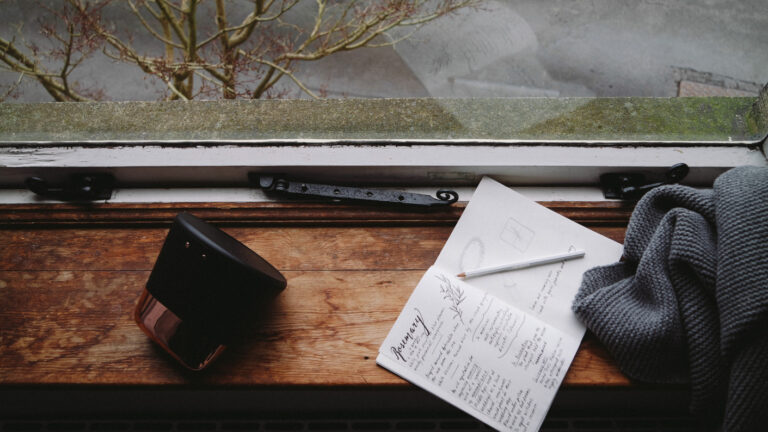‘Productivity’ is a funny old concept. We like to imagine that as humans we’re designed to work non-stop from 9-5, stopping only to eat or drink coffee here and there. In fact we’re so attached to this idea of virtuous productivity that we use it as a standard to measure ourselves against, even though for most of us, our work experience gives no reason to believe it is real.
The truth is, that like creativity, inspiration, willpower and desire, our productivity is in a constant state of flux, and is heavily impacted by our energy levels, our feelings about the work or project and our motivations for doing it at all.
Checking in
Before we even think about ‘productivity’, it makes sense to check in on all these factors. Are you eating right? Drinking enough water? Getting enough sleep at night? Remembering to leave the house at least once a day? Checking in on these basic functions can often reveal glaring areas of self neglect that fully explain why our body and brain aren’t performing on demand like as we’d like. It’s a bit like not putting petrol in your car, then being surprised when it wont run. (Which I’ve actually done. Er, more than once.)
The second thing to check is, could our resistance be trying to tell us something? Of course we want to just push it to the side and get on with the business of doing, but shoving away feelings is rarely a good idea in life. Pausing to remember why we want to do this thing can either strengthen our motivation (e.g., you’ve got bills to pay and this work will help with that) or help us see that we’re chasing the wrong goal (e.g trying to compete).
Gently taking the time to figure all this stuff out means we can focus on the projects and tasks that are truly right for us, that will best move our business forwards. Or, if you’re part of a bigger business and the task really does have to be done, you can at least be more sympathetic with yourself, and try to work in a better motivation or reward to keep yourself on target.
But sometimes, despite all of this, we can still find it hard to get going.
For me it’s usually tied up in perfectionism, procrastination and fatigue, but I’ve managed to find a handful of strategies that help me get moving when it feels like I’m walking through treacle.
Crucially, they’re all slow and gentle in nature. I’ve great respect for the ‘pomadoro method‘ and bullet journal-ers of this world but so far, those things have all felt too frantic and busy to become a part of my daily life. I lived that way for my first two years of self employment, and it left me strung-out and stressed.
So, here are 5 gentle ways I have found to get myself to get to work.

Slow Living Strategies to stay focused and productive
Burn a candle.
I buy beautiful scented candles and light them only when I work. It’s a lovely ritual – even the matches are kept in a lovely jar – and I get to choose scents based on my mood or feelings that day. When I finish, for any reason, I blow the candle out.
It’s a nice, loose way for me to keep track of how many hours I’m working without having to watch the clock. If the candle burns lower faster than expected, then I know I’m overdoing it. If it’s still full at the end of the week, I know I’ll need to do more next week. Plus, anything that infuses my computer time with natural scents and soothing, flickering light is a welcome addition to my routine and daily life.
Use a sand timer
One thing I did take from trialling the pomade method (and, once upon a time, Fly Lady), was the idea that you can do anything for a specified time period. Those jobs that we put off or find unpleasant are much easier to face when we have a limited timeframe, because we make a little game of it in our heads and try to beat the clock. Except, I find ticking clocks and alarm sounds, well, alarming, and as someone with a bad case of time optimism, I often find it hard to appropriately pace myself within a period. Enter, the sand timer. It’s silent. It’s hypnotic, and equally ignorable. It’s a thing of romantic, old world beauty (or stark minimalist beauty, if you;re shopping the Hay range). And best of all, it’s a visual representation of time. I can glance and see I am half way through, or there’s too thirds left, and know how much longer I have to finish.
Elizabeth Gilbert touches on this idea in one of her Magic Lessons podcast episodes, featuring writer Neil Gaimon. Neil mentions taking himself away to a cabin to write, and giving himself only two daily options: watch the view from the window, or write. Very soon, he said, he started to write just to alleviate his boredom. And that’s how I am with my sand timer. I can watch it for 15 minutes, if my brain needs that time. It’s like a quiet sort of meditation and I believe there is real value in that. But usually, my brain starts to demand stimulation after 25 seconds, and then I fly through my inbox, and feel great by the time the sand has run out.
There are actually a whole heap of variants of this idea available, ranging from ‘two minute’ to ‘ten minute’, and all have a slightly different approach. I chose the one that seemed most simple and to have decent research behind it (and ok, perhaps that was the quickest to complete) – The Two Minute Morning by Neil Pasricha. Each morning you sit down and complete the same three sentences: I will let go of, I am grateful for, I will focus on. It’s a quick but powerful way to get your head in the right place to work from, and far more useful than writing a two page to do list that makes you want to hide under the desk. You don’t actually need to buy the book in order to do this – in fact, I don’t love the branding of the journal, and often just write my answers in my own notebook instead. But of course if you can afford it, it’s always best to support the creator, and there are some helpful bits of background and research included in the printed version too.
I like to imagine a world where kids start their school days with an activity like this; where your inbox pops up and asks you before it will let you log in. Checking in with our inner world and our priorities is so important, and something all too often overlooked in the pursuit of outcomes.

Break it down. In tandem with this idea of a to-do list reimagined is the importance of breaking stuff down into achievable steps. I’m talking tiny steps, sometimes. How often do we write something on our to do list each day like “send newsletter” or, my recent favourite, “write book”? Huge jobs like that are seldom ticked off in one day, and with very good reason – because they are actually approx twenty jobs hiding behind a single subheading. To send a newsletter I actually have to collate hashtags, research each one, reach out to creators, type copy for each, collect links, input this all into a mailing list client, format it all, choose images, remind people to sign up, write and add any other promotional content, proof read and link check, then schedule and send it, then tell people it’s gone out. Those are the tasks that I need to be putting on my to-do list – and it would be crazy to expect that I could complete them all in the space of a single day.
If you struggle to break tasks down like this, or if you’re just new to it, the Get To Work Book has a great page for this. You get them throughout the planner copy, or you can buy it as a dedicated notepad instead. Again, it’s not necessary – any old piece of paper could substitute – but I do find the planner page helps.
Be kind to yourself. Tradition, religion and education all conspire to teach us that when we don’t get stuff done, we need to be chastised – told to push harder, work longer, be less lazy. What’s wrong with you? Look at all this wasted time! It’s weird that this mentality is so tenacious, because it doesn’t actually help. Panicking about time, or hating our own brains is generally just a surefire way to chase off creativity and teach ourselves to dread sitting down at the desk. The only way to get stuff done it to turn up again after every failure with an open mind, believing today will be different. No judgement, no blame. Just optimism and compassion for ourselves, and forgiveness when things don’t go as planned.
As I mentioned in #10 of this post, realising that my brain just likes to do things at the last minute and that there’s going to be no changing that, was a huge lightbulb moment in my working life. Now I don’t waste my energy fighting my natural tendencies, and instead get to plan and accommodate for now I work.
A feathered friend. While of course I’m not suggesting everyone rushes out to buy one, having a tiny parrot perched on my shoulder while I work has proven to be a surprisingly motivating perk. Jack will groom my hair, steal sips of my tea and occasionally murmur comforting little phrases like “its a common experience” or “to the rescue!“. Granted, sometimes he also poops on my shoulder, but nothing is perfect, and the quiet company does me a lot of good. Because the birds are only allowed in the workroom (for safety – it’s the one room the cats cannot enter), if I want to hang out with him, I need to be at my desk. Therefore, having budgies is making me more productive, and when they burst into song in the middle of the afternoon, perhaps a little bit more peaceful, too.

What tricks do you use to stay on task, or to simply get started? Any ideas I can adopt?
Hashtags for Instagram
Every month, I gather up a selection of winning hashtags and send them straight to your inbox, for free.
Sign up to receive my newsletters every month.







No Comments Yet